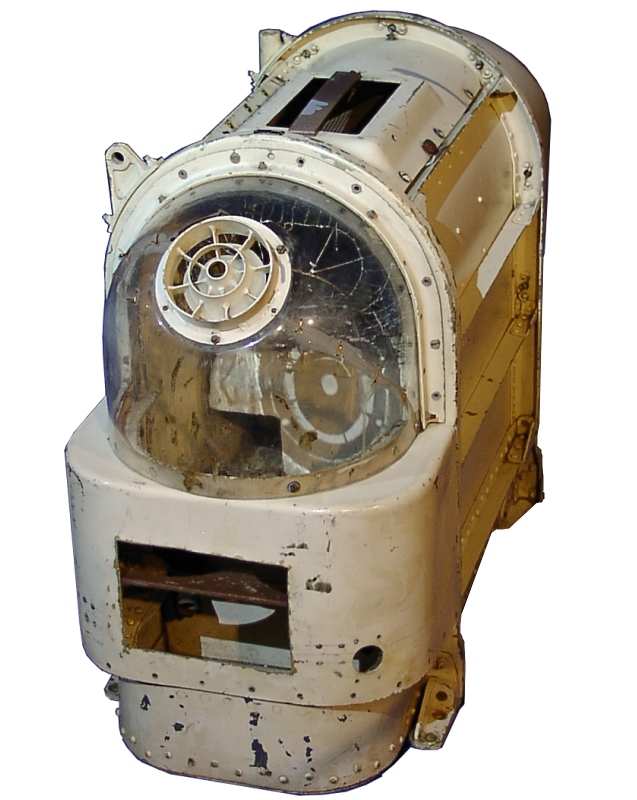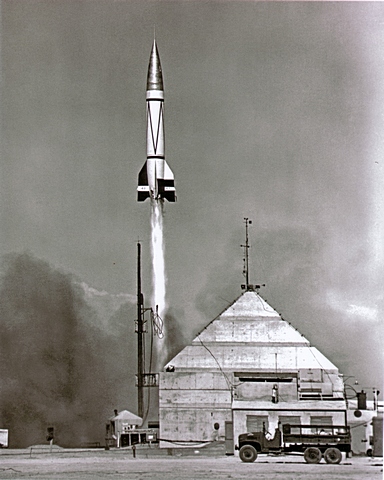|
Belka And Strelka
Belka (Белка, literally, "squirrel", or alternatively "Whitey") and Strelka (Стрелка, "Arrow") were dogs that spent a day in space aboard Korabl-Sputnik 2 (Sputnik 5) on 19 August 1960 before safely returning to Earth. They were the first higher living organisms to survive an orbital trip in outer space. They were accompanied by 42 mice, a grey rabbit, two rats, flies, and several plants and fungi. All passengers survived. Sputnik 5 made 17 revolutions around the Earth and spent 27 hours in orbit. These were the first Earth-born creatures to orbit Earth and return alive, and the first recovered since February 20, 1947, when fruit flies were flown into space on a suborbital flight by the U.S. and survived. The objective of the mission was to check and understand the organisms' reactions to exposure to zero gravity in outer space. Strelka went on to have six puppies with a male dog named Pushok who participated in many ground-based space experiments, but never made it ... [...More Info...] [...Related Items...] OR: [Wikipedia] [Google] [Baidu] |
Belka & Strelka 50 Years Flight Stump
BelKA or BKA (an acronym from Belarusian: Беларускі Касмічны Апарат, Belarusian Cosmic Apparatus) is the first satellite of independent Belarus. First attempt It was a remote sensing satellite that utilizes the USP (satellite bus), developed by Belarusian researchers and Russian Rocket and Space Corporation RSC Energia for National Academy of Sciences of the Republic of Belarus as the final customer of the satellite, which had the capacity to take photos of the Earth surface, with a maximum resolution of 2-2.5 meters. BelKA was launched, along with seventeen other satellites, on July 26, 2006 at 19:43 GMT, however 86 seconds later, the Dnepr rocket suffered an engine failure and crashed, destroying the satellites. The name BelKA is thought to be an allusion to the Soviet space dog, Belka, who, together with Strelka orbited the Earth and returned safely on Sputnik 5 in 1960. * Configuration: Victoria bus * Outcome: Carrier rocket failure, satellite d ... [...More Info...] [...Related Items...] OR: [Wikipedia] [Google] [Baidu] |
List Of Individual Dogs
The following is a list of individual dogs. Actors Advertising * Alex the dog, Banjo, portrayed Carlos, an Irish Setter-Golden Retriever mix and star of Stroh Brewery Company, Stroh's beer advertising in the 1980s. Also mentioned in the 1989 Tone Lōc song "Funky Cold Medina". * Cheeka (dog), Cheeka, a Pug who appeared in the popular "You & I" advertising campaign of Hutch (mobile phone network), Hutch's cellular service in India, along with the child actor Jayaram. * Taco Bell chihuahua, Gidget, a female Chihuahua (dog), Chihuahua, was featured in a Taco Bell advertising campaign as the "Taco Bell Chihuahua". She also played the role of Bruiser's mother in the 2003 film ''Legally Blonde 2''. * Spuds MacKenzie, Honey Tree Evil Eye, a female Bull Terrier, was known as Spuds MacKenzie in her role as the Budweiser spokes-dog. * Nipper, the dog with the gramophone in the 1901 His Master's Voice logo. * Bush Brothers and Company, Sam, a Golden Retriever "professional stand-in, a ... [...More Info...] [...Related Items...] OR: [Wikipedia] [Google] [Baidu] |
Dogs In The Soviet Union
The dog (''Canis familiaris'' or ''Canis lupus familiaris'') is a domesticated descendant of the gray wolf. Also called the domestic dog, it was selectively bred from a population of wolves during the Late Pleistocene by hunter-gatherers. The dog was the first species to be domesticated by humans, over 14,000 years ago and before the development of agriculture. Due to their long association with humans, dogs have gained the ability to thrive on a starch-rich diet that would be inadequate for other canids. Dogs have been bred for desired behaviors, sensory capabilities, and physical attributes. Dog breeds vary widely in shape, size, and color. They have the same number of bones (with the exception of the tail), powerful jaws that house around 42 teeth, and well-developed senses of smell, hearing, and sight. Compared to humans, dogs possess a superior sense of smell and hearing, but inferior visual acuity. Dogs perform many roles for humans, such as hunting, herding, pullin ... [...More Info...] [...Related Items...] OR: [Wikipedia] [Google] [Baidu] |
Animal Testing In The Soviet Union
Animals are multicellular, eukaryotic organisms in the biological kingdom Animalia (). With few exceptions, animals consume organic material, breathe oxygen, have myocytes and are able to move, can reproduce sexually, and grow from a hollow sphere of cells, the blastula, during embryonic development. Animals form a clade, meaning that they arose from a single common ancestor. Over 1.5 million living animal species have been described, of which around 1.05 million are insects, over 85,000 are molluscs, and around 65,000 are vertebrates. It has been estimated there are as many as 7.77 million animal species on Earth. Animal body lengths range from to . They have complex ecologies and interactions with each other and their environments, forming intricate food webs. The scientific study of animals is known as zoology, and the study of animal behaviour is known as ethology. The animal kingdom is divided into five major clades, namely Porifera, Ctenophora, Placozoa, Cn ... [...More Info...] [...Related Items...] OR: [Wikipedia] [Google] [Baidu] |
Dogs In Human Culture
The dog (''Canis familiaris'' or ''Canis lupus familiaris'') is a domesticated descendant of the gray wolf. Also called the domestic dog, it was selectively bred from a population of wolves during the Late Pleistocene by hunter-gatherers. The dog was the first species to be domesticated by humans, over 14,000 years ago and before the development of agriculture. Due to their long association with humans, dogs have gained the ability to thrive on a starch-rich diet that would be inadequate for other canids. Dogs have been bred for desired behaviors, sensory capabilities, and physical attributes. Dog breeds vary widely in shape, size, and color. They have the same number of bones (with the exception of the tail), powerful jaws that house around 42 teeth, and well-developed senses of smell, hearing, and sight. Compared to humans, dogs possess a superior sense of smell and hearing, but inferior visual acuity. Dogs perform many roles for humans, such as hunting, herding ... [...More Info...] [...Related Items...] OR: [Wikipedia] [Google] [Baidu] |
Individual Dogs
The following is a list of individual dogs. Actors Advertising * Banjo, portrayed Carlos, an Irish Setter- Golden Retriever mix and star of Stroh's beer advertising in the 1980s. Also mentioned in the 1989 Tone Lōc song " Funky Cold Medina". * Cheeka, a Pug who appeared in the popular "You & I" advertising campaign of Hutch's cellular service in India, along with the child actor Jayaram. * Gidget, a female Chihuahua, was featured in a Taco Bell advertising campaign as the "Taco Bell Chihuahua". She also played the role of Bruiser's mother in the 2003 film '' Legally Blonde 2''. * Honey Tree Evil Eye, a female Bull Terrier, was known as Spuds MacKenzie in her role as the Budweiser spokes-dog. * Nipper, the dog with the gramophone in the 1901 His Master's Voice logo. * Sam, a Golden Retriever "professional stand-in, and stunt double", portrays the real Duke Bush (Duffy "Duke" of Castlebury) at promotional events and in commercials for Bush's Best Baked Beans. * ... [...More Info...] [...Related Items...] OR: [Wikipedia] [Google] [Baidu] |
Soviet Cosmonauts
This is a list of cosmonauts who have taken part in the missions of the Soviet space program and the Russian Federal Space Agency, including ethnic Russians and people of other ethnicities. Soviet and Russian cosmonauts born outside Russia are marked with an asterisk and their place of birth is shown in #Soviet and Russian cosmonauts born outside Russia, an additional list. For the full plain lists of Russian and Soviet cosmonauts in Wikipedia, see :Russian cosmonauts, Russian cosmonauts Five female cosmonauts have flown on the Soviet/Russian program: Valentina Tereshkova, Svetlana Savitskaya, Yelena Kondakova, Yelena Serova and Anna Kikina. Russian and Soviet cosmonauts A * Viktor Mikhaylovich Afanasyev — Soyuz TM-11, Soyuz TM-18, Soyuz TM-29, Soyuz TM-33/Soyuz TM-32, 32 * Vladimir Aksyonov (1935–2024) — Soyuz 22, Soyuz T-2 * Aleksandr Pavlovich Aleksandrov — Soyuz T-9, Soyuz TM-3 * Ivan Anikeyev (1933–1992) — Expelled from Vostok program; no flights. *Ole ... [...More Info...] [...Related Items...] OR: [Wikipedia] [Google] [Baidu] |
Sputnik
Sputnik 1 (, , ''Satellite 1''), sometimes referred to as simply Sputnik, was the first artificial Earth satellite. It was launched into an elliptical low Earth orbit by the Soviet Union on 4 October 1957 as part of the Soviet space program. It sent a radio signal back to Earth for three weeks before its three silver-zinc batteries became depleted. Aerodynamic drag caused it to fall back into the atmosphere on 4 January 1958. It was a polished metal sphere in diameter with four external radio antennas to broadcast radio pulses. Its radio signal was easily detectable by amateur radio operators, and the 65° orbital inclination made its flight path cover virtually the entire inhabited Earth. The satellite's success was unanticipated by the United States. This precipitated the American Sputnik crisis and triggered the Space Race. The launch was the beginning of a new era of political, military, technological, and scientific developments. The word ''sputnik'' is Russian for ... [...More Info...] [...Related Items...] OR: [Wikipedia] [Google] [Baidu] |
Soviet Space Dogs
During the 1950s and 1960s the Soviet space program used dogs for sub-orbital and Orbital spaceflight, orbital space flights to determine whether human spaceflight was feasible. The Soviet space program typically used female dogs due to their anatomical compatibility with the spacesuit. Similarly, they used mix-breed dogs due to their apparent hardiness. In this period, the Soviet Union launched missions with passenger slots for at least 57 dogs. Some dogs flew more than once. Most survived; those that died were lost mostly through technical failures, according to the parameters of the test. Laika was an exception and was expected to die during her Earth-orbiting 3 November 1957 Sputnik 2. Training Dogs were the preferred animal for the experiments because scientists felt dogs were well suited to endure long periods of inactivity. As part of their training, they were confined in small boxes for 15–20 days at a time. Stray dogs, rather than animals accustomed to living in ... [...More Info...] [...Related Items...] OR: [Wikipedia] [Google] [Baidu] |
Squirrel
Squirrels are members of the family Sciuridae (), a family that includes small or medium-sized rodents. The squirrel family includes tree squirrels, ground squirrels (including chipmunks and prairie dogs, among others), and flying squirrels. Squirrels are indigenous to the Americas, Eurasia, and Africa, and were introduced by humans to Australia. The earliest known fossilized squirrels date from the Eocene epoch, and among other living rodent families, the squirrels are most closely related to the mountain beaver and dormice. Etymology The word ''squirrel'', first attested in 1327, comes from the Anglo-Norman which is from the Old French , the reflex of a Latin language">Latin word , which was taken from the Ancient Greek word (; from ) 'shadow-tailed', referring to the long bushy tail which many of its members have. ''Sciurus'' is also the name of one of its genuses. The native Old English language, Old English word for the squirrel, , only survived into Middle Eng ... [...More Info...] [...Related Items...] OR: [Wikipedia] [Google] [Baidu] |
Animals In Space
Animals in space originally served to test the survivability of spaceflight, before human spaceflights were attempted. Later, many species were flown to investigate various biological processes and the effects microgravity and space flight might have on them. Bioastronautics is an area of bioengineering research that spans the study and support of life in Outer space, space. To date, seven national space programs have flown non-human animals into space: the United States, Soviet Union, France, Argentina, China, Japan and Iran. A wide variety of non-human animals have been launched into space, including monkeys in space, monkeys and apes, Dogs in space, dogs, Félicette, cats, tortoises, mice, rats, rabbits, fish, frogs, spiders, insects, and quail eggs (which hatched on ''Mir'' in 1990). The US launched the first Earthlings into space, with Fruit flies in space, fruit flies surviving a 1947 flight, followed by primates in 1949. The Soviet space program launched Soviet space d ... [...More Info...] [...Related Items...] OR: [Wikipedia] [Google] [Baidu] |









